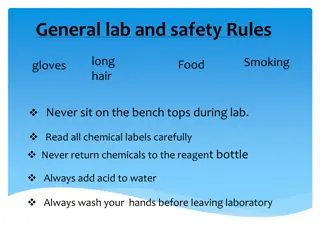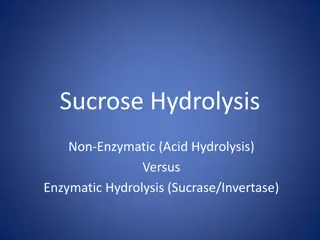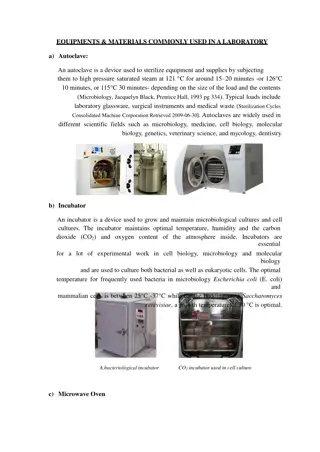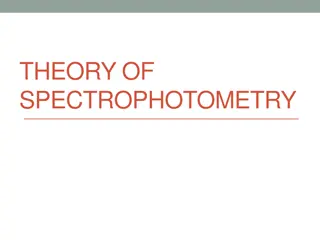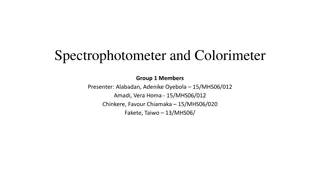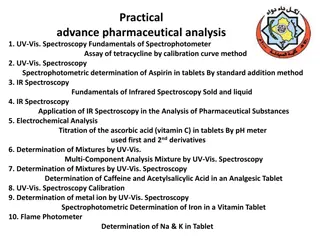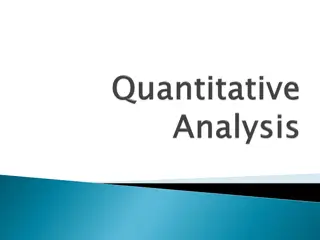General lab and safety Rules
Laboratory safety rules include guidelines on handling chemicals, wearing appropriate gear, and following proper procedures. Analytical chemistry involves qualitative and quantitative analysis methods using classical and instrumental approaches. Techniques such as gas chromatography, spectrophotomet
0 views • 27 slides
Understanding Atomic Absorption Spectrophotometry in Analytical Chemistry
Atomic absorption spectrophotometry (AAS) is a spectro-analytical technique used for quantitative determination of chemical elements through the absorption of light by free atoms. This method is vital in various fields like biophysics, toxicology, and archaeology, allowing the analysis of over 70 di
0 views • 9 slides
Understanding Sucrose Hydrolysis and Reducing Sugars in Carbohydrate Chemistry
This content delves into the mechanisms of sucrose hydrolysis through non-enzymatic and enzymatic processes, highlighting disaccharides like sucrose, lactose, and maltose. It explores the significance of glycosidic bonds in carbohydrate structures and discusses the reducing capacity of sugars such a
7 views • 16 slides
Advanced Analysis in Pharmacy: Deviations from Beer-Lambert Law
Explore the complexities of advanced analysis in pharmacy through deviations from Beer-Lambert Law, including real, instrumental, and chemical deviations. Understand limitations, causes of nonlinearity, and the role of instrumentation in spectrophotometry. Dive into topics such as irregular and regu
0 views • 41 slides
Essential Laboratory Equipment and Materials
Autoclaves, incubators, microwaves, vacuum furnaces, freezers, centrifuges, spectrophotometers, and analytical balances are commonly used in laboratories for sterilization, culture growth, sample preparation, drying, storage, precipitation, spectrophotometry, and precise weight measurements. These e
0 views • 9 slides
Analytical Toxicology: Techniques and Sample Analysis in Clinical Toxicology
Analytical toxicology involves the observation, identification, and measurement of foreign compounds in biological and other samples, such as urine, blood, stomach contents, nails, hair, and DNA. Various techniques are used to isolate and identify drugs and poisons present in these samples. This fie
0 views • 12 slides
Understanding Spectrophotometry: Principles and Applications
Spectrophotometry is a valuable method for measuring the absorption of light by chemical substances, aiding in quantitative analysis in various fields such as chemistry, biochemistry, and clinical applications. This technique involves utilizing spectrophotometers to detect the intensity of light abs
0 views • 21 slides
Understanding the Functions and Principles of Spectrophotometry
Spectrophotometry is a vital technique in various scientific fields, allowing for the quantitative measurement of the reflection or transmission properties of materials based on principles like Lambert's Law and Beer's Law. This instrument, comprising a monochromator and a means of measuring light i
0 views • 21 slides
Practical Advances in Pharmaceutical Analysis Using Spectroscopy Techniques
This comprehensive guide covers various spectroscopy techniques, including UV-Vis and IR spectroscopy, as well as electrochemical analysis and flame photometry, for pharmaceutical analysis. It delves into the fundamentals of molecular spectroscopy, discussing electromagnetic radiation, quantum energ
0 views • 19 slides
Understanding UV-Visible Spectrophotometry for Quantitative Analysis
Spectrometry in quantitative analysis involves determining substance concentration through spectrophotometry. UV-Visible Spectrophotometry measures light absorption in the UV or visible region using the Beer-Lambert Law, relating absorbance to substance concentration. The electromagnetic spectrum en
0 views • 15 slides
